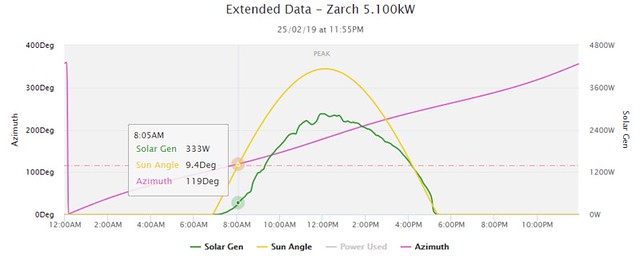We’d like to remind Forumites to please avoid political debate on the Forum.
This is to keep it a safe and useful space for MoneySaving discussions. Threads that are – or become – political in nature may be removed in line with the Forum’s rules. Thank you for your understanding.
📨 Have you signed up to the Forum's new Email Digest yet? Get a selection of trending threads sent straight to your inbox daily, weekly or monthly!
Sun height (angle) more important than azimuth
Zarch
Posts: 393 Forumite





In better trying to understand my new system I've become interested in the interaction between azimuth and sun angle..... and its affect on solar generation for my setup.
-- Angle being the vertical height of the sun in the sky
-- Azimuth being the horizontal position, ie when it moves sideways across the sky.
I initially found this via the SunEarthTools website that piqued my interest and understanding:

You can create your own chart by simply entering your postcode: https://www.sunearthtools.com/dp/tools/pos_sun.php?lang=en
My setup starts with 3 x 29 degree panels facing 97 azimuth. (6:15am)
I than have a variety of panel angles, especially on the 215 degree azimuth (which for me is around 2:15pm)
My 215 degree SSW panel angles are:
8 x 35 degrees
2 x 26 degrees
4 x 15 degrees (flat roof)
I wanted to know the azimuth and sun angle through the day and stick them on my generation charts, so I wrote myself a python script to pull the info using the PySolar module on squirt that up to PVOutput. Here's the result.

If you're interested in the code its discussed here on the EmonPi forum: https://community.openenergymonitor.org/t/pvoutput-python-script-emoncms-org-pvoutput/10112
So what I have I learnt?
Sun height is more important (at this time of the year) to my setup than azimuth. Even though the best angle to hit my panels straight on at 2:15pm, I still get the best generation at noon when the panels are highest. The sun is 6 or 7 degrees higher this week at noon than at 2:15pm.
This makes sense, especially as I have some shallow panel angles.
Maybe if I had steep panels things may be different. So folk on the forum have 45/50 degree panels are really make hay during the winter.
The aim being to hit the panels bang in the middle of both horizontal and vertical angles? If you're not hitting bang centre then you don't get 100% generation?
Right now, my peak height angle is 27.5 degrees, but in a months time it will be closer to 40 degrees and at solstice (mid June) it will be 60 degrees.
Hope this waffling makes sense and you can pull something useful out of it. :rotfl:
I will watch on with interest as the sun gets higher over the coming months.
Any thoughts?
-- Angle being the vertical height of the sun in the sky
-- Azimuth being the horizontal position, ie when it moves sideways across the sky.
I initially found this via the SunEarthTools website that piqued my interest and understanding:

You can create your own chart by simply entering your postcode: https://www.sunearthtools.com/dp/tools/pos_sun.php?lang=en
My setup starts with 3 x 29 degree panels facing 97 azimuth. (6:15am)
I than have a variety of panel angles, especially on the 215 degree azimuth (which for me is around 2:15pm)
My 215 degree SSW panel angles are:
8 x 35 degrees
2 x 26 degrees
4 x 15 degrees (flat roof)
I wanted to know the azimuth and sun angle through the day and stick them on my generation charts, so I wrote myself a python script to pull the info using the PySolar module on squirt that up to PVOutput. Here's the result.

If you're interested in the code its discussed here on the EmonPi forum: https://community.openenergymonitor.org/t/pvoutput-python-script-emoncms-org-pvoutput/10112
So what I have I learnt?
Sun height is more important (at this time of the year) to my setup than azimuth. Even though the best angle to hit my panels straight on at 2:15pm, I still get the best generation at noon when the panels are highest. The sun is 6 or 7 degrees higher this week at noon than at 2:15pm.
This makes sense, especially as I have some shallow panel angles.
Maybe if I had steep panels things may be different. So folk on the forum have 45/50 degree panels are really make hay during the winter.
The aim being to hit the panels bang in the middle of both horizontal and vertical angles? If you're not hitting bang centre then you don't get 100% generation?
Right now, my peak height angle is 27.5 degrees, but in a months time it will be closer to 40 degrees and at solstice (mid June) it will be 60 degrees.
Hope this waffling makes sense and you can pull something useful out of it. :rotfl:
I will watch on with interest as the sun gets higher over the coming months.
Any thoughts?
17 x 300W panels (5.1kW) on a 3.68kW SolarEdge system in Sunny Sheffield.
12kW Pylontech battery storage system with Lux AC controller
Creator of the Energy Stats UK website and @energystatsuk Twitter Feed
12kW Pylontech battery storage system with Lux AC controller
Creator of the Energy Stats UK website and @energystatsuk Twitter Feed
0
Comments
-
45-50 deg slope is best for about now. Actually a 53 deg slope would be ideal on 21st March or 21st September. 30 deg would be ideal on 21st June and you'd really need 76 deg to be ideal on 21st December.Maybe if I had steep panels things may be different. So folk on the forum have 45/50 degree panels are really make hay during the winter.
But unless you're fitting an adjustable (prob ground mounted) array or setting out to design a new house you usually just have to accept whatever slope your roof is.
But it's not just about getting the panels square on to the sun; there's also the additional effect that the higher in the sky the sun appears, the less thickness of atmosphere it's light is going through - i.e. a low winter sun will appear weaker after it's gone through a longer air path.NE Derbyshire.4kWp S Facing 17.5deg slope (dormer roof).24kWh of Pylontech batteries with Lux controller BEV : Hyundai Ioniq50 -
Another consideration here (linked to above) is what are you trying to achieve?
If your panels are flatter you'll increase generation in the summer (when the sun is higher in the sky) whereas if they're more vertical you'll increase generation in the winter (when the sun is lower in the sky).
If you do the (complicated!) maths you can work out the optimum angle for overall generation over the course fo the year, but this may lead to excess generation in the summer you can't actually use.
Setting the panels more vertical will result in lower overall generation through the year but will increase winter and decrease summer generation, which may mean that you actually end up with more "usable" solar power.0 -
There is a good site I used of which the most useful one is this.
Fixed Adj. 2 seasons Adj. 4 seasons 2-axis tracker
% of optimum 71.1% 75.2% 75.7% 100%
https://www.solarpaneltilt.com
So compared to an all singing, all dancing two axis filter you lose less than 30% of the capacity with fixed tilt or 25% if you change the tilt twice a year. Personally I don't think that's too bad.
They reckon the best angle for fixed panels is latitude x 0.76 + 3.1degrees which probably isn't far off most people's pitched roofs in the UK.0 -
[quote=[Deleted User];75521662]
Setting the panels more vertical will result in lower overall generation through the year but will increase winter and decrease summer generation, which may mean that you actually end up with more "usable" solar power.[/QUOTE]
This is something I pondered a few years back when discussing max gen, and a falling FiT rate. Do you want max generation, or max usability.
For an off-gridder, who is dependent on generation, they'll design for winter gen with steep panels. Chatting on renewables forums, the off-gridders in the UK seem to ground mount at around 50d.
But, the benefits apply to on-grid too, as you point out with 'usable' generation, as reduced summer gen will mostly cut export at low value, whilst additional winter gen will mostly be consumed and off-set import prices.
Also the annual 'losses' are quite small:
PVGIS pin in Oxford for south facing gives (in kWh/kWp)
35d pitch
Annual - 974
December - 30.8
June - 118
50d pitch
Annual - 962
December - 34.7
June - 109
60d pitch
Annual - 927
December - 36.1
June - 100
So even an extreme 60d pitch is only an annual loss of 5%, but boosts Dec gen by 17%, and flattens out the summer months.Mart. Cardiff. 8.72 kWp PV systems (2.12 SSW 4.6 ESE & 2.0 WNW). 28kWh battery storage. Two A2A units for cleaner heating. Two BEV's for cleaner driving.
For general PV advice please see the PV FAQ thread on the Green & Ethical Board.0 -
[quote=[Deleted User];75521662]Another consideration here (linked to above) is what are you trying to achieve?
[/QUOTE]
There is nothing I can achieve, everything is fixed to my roof and cannot change...... i'm just a curious geek who is eager to learn the nuances of my setup. :rotfl:17 x 300W panels (5.1kW) on a 3.68kW SolarEdge system in Sunny Sheffield.
12kW Pylontech battery storage system with Lux AC controller
Creator of the Energy Stats UK website and @energystatsuk Twitter Feed0 -
So I have some W facing panels and some S facing panels.
Can't remember the exact numbers but I think overall the W facing generate about 10% less power per annum but in the winter it is about 20% per day.
All panels are 35 degrees.I think....0 -
There is nothing I can achieve, everything is fixed to my roof and cannot change...... i'm just a curious geek who is eager to learn the nuances of my setup. :rotfl:
Same here, but ...... I have a nice tall(ish) E/W fence in the garden with little shading, so I can pop some ground mount panels against it at any angle I choose, and facing south.
If I go with 4m / 4 vertical panels of 330Wp, then at 50d pitch and 1.3kWp I'd get around 1,250kWh additional generation, but more important, I get about 45kWh in Dec, v's the target my whole 5.58kWp has of 79kWh. So 23% more PV and 57% more Dec gen.
Not only would this boost excess (without a battery) allowing my A/C to be more PV powered, but I suspect it would allow me to install a second A/C unit.
Yes, I am jealous of the 'southers' in the winter.
Edit - it would also help remove the mid day dip I get in Dec/Jan where generation falls as the sun gets to the south as it's simply too low to hit either roof, so I get a double hump on generation even on a sunny day!Mart. Cardiff. 8.72 kWp PV systems (2.12 SSW 4.6 ESE & 2.0 WNW). 28kWh battery storage. Two A2A units for cleaner heating. Two BEV's for cleaner driving.
For general PV advice please see the PV FAQ thread on the Green & Ethical Board.0 -
What’s to stop (assuming some tangible gain) being able to tilt the angle of the panels for the winter months by, say, 5 or 10 degrees? A bit like old cars used to have a summer and a winter setting on the cooling system.
Obviously there will be issues around ridge height and the fact that the panels will have a larger gap and not be parallel to the roof but surely if there is a potential gain then any problems shouldn’t be insurmountable in this day and age. Saying all that, I’d guess a cost/benefit analysis would blow it all out of the water as a retrofit anyway.
So.... how about a cost effective, low wattage wind turbine to cover most of one’s baseload?0 -
The whole scenario of what is the best angle and azimuth will vary from one person's situation to the next and what one is attempting to achieve.
When FiT rates were high, in the early days of PV installations, it made sense to try to have the best angle and azimuth to achieve the greatest power output, but now with the current FiT rate being so low, it can be argued that to achieve the greatest saving will be to reduce the power supplied by the grid (FiT in the order of 9p /kWh and grid electricity up around 17p/kWh).
As far as the azimuth is concerned, if you can only have one set of panels, to have the panels facing more east will be better for those at home in the morning and those to the west will be more advantageous for those at home in the evening.
During the winter most of the days are dull, solid cloud.
If for instance you have a base-load of 330W and during the winter months you can just cover this for the 6 hours a day of daylight (2kWh), this would be better than having a perfect angle and getting 4kW for 30 minutes of sunshine if the base-load were not covered for the rest of the daylight. It is generally the base-load which 'bumps up' the electricity bill and not the 2kW kettle / washing machine heater / ... that is on for a short time each day.
Consider a dull winter's day with no sunshine, if the solar panels are mounted on a flat roof, their horizon is 360 degrees with a 180 degree vertical aspect. If they were mounted, south facing, on a near vertical plane, their 'horizon' is 180 degrees and 'vertical aspect' 90 degrees. So the output from these panels on a cloudy day would be half of that for those on the flat roof.
Putting these two set-ups through PVGIS would of course render a different story because the PVGIS figure would include the high peaks of power on the occasional sunny day. But unless you can store this peak power in batteries, for the remainder of the time once the clouds return, the base-load may not be covered.
I don't think there is one perfect angle and azimuth for everyone. It is a complicated equation with a different answer for each situation.
Dave FSolar PV System 1: 2.96kWp South+8 degrees. Roof 38 degrees. 'Normal' system
Solar PV System 2: 3.00kWp South-4 degrees. Roof 28 degrees. SolarEdge system
EV car, Evec charger
Lux LXP 3600 ACS + 6 x 2.4kWh Aoboet LFP 2400 battery storage. Installed Feb 2021
Location: Bedfordshire0
This discussion has been closed.
Confirm your email address to Create Threads and Reply

Categories
- All Categories
- 352.9K Banking & Borrowing
- 253.9K Reduce Debt & Boost Income
- 454.7K Spending & Discounts
- 246K Work, Benefits & Business
- 602K Mortgages, Homes & Bills
- 177.8K Life & Family
- 259.9K Travel & Transport
- 1.5M Hobbies & Leisure
- 16K Discuss & Feedback
- 37.7K Read-Only Boards





